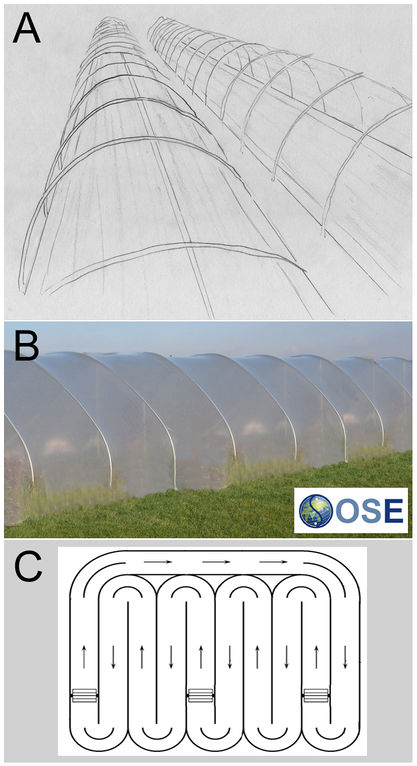LongPondGreenhouse: Difference between revisions
(Created page with "Image:LongPondGreenhouse - sketch.jpg|417px|thumb|right| Concept of the “LongPondGreenhouse”: (A) Sketch, demonstrating long rows of this greenhouse. The inner surface i...") |
|||
| Line 34: | Line 34: | ||
* Due to the very high moisture, [[Algae|microalgae]] growth on the inside of the foil is likely. This may be minimized with the use of non-stick (i.e. “Teflon”, ETFE/PTFE) foil, which is far more expensive however. | * Due to the very high moisture, [[Algae|microalgae]] growth on the inside of the foil is likely. This may be minimized with the use of non-stick (i.e. “Teflon”, ETFE/PTFE) foil, which is far more expensive however. | ||
* earth sheltered on one side (in high latitudes) – would provide extra insulation and structural support but block out some of the light. It would allow for a very inexpensive build with simple, straight, short beams of wood or concrete. | * earth sheltered on one side (in high latitudes) – would provide extra insulation and structural support but block out some of the light. It would allow for a very inexpensive build with simple, straight, short beams of wood or concrete. | ||
* night-time cover with insulating material to minimize heat losses | |||
[[Category:Controlled-environment growing]] | [[Category:Controlled-environment growing]] | ||
[[Category:Food and Agriculture]] | [[Category:Food and Agriculture]] | ||
[[Category:Housing and construction]] | [[Category:Housing and construction]] | ||
Revision as of 16:39, 7 May 2016

Idea
This is a concept for a simple greenhouse-like structure that has a long pond inside and is used exclusively for the production of floating plants such as duckweed and azolla. The installation has a low height (1-2 m), which helps to greatly reduce costs for the structural supports. Once the function of the greenhouse is reduced, then there is no need for human access. There is only a small volume of CO2-enriched air above it. The water is warm and temperature is maintained by the large amount of circulating water. The structure is entirely sealed off in order to prevent water losses and may therefore be well-suited for dryland farming. A CO2 source will be required (e.g. combination with adjacent composting system, which would also be a good heat source). “Farming” this pond can be highly automated, with very simple floating robots moving the crops to the harvest points.
Other aspects:
- These „farms“ could be very suitable for the drylands (e.g. Central Asia, Africa, Asia).
- This is not too different from the spirulina farm concept built by Jean-Paul Jourdan.
- The structural support can be something cheap like wood or bamboo (problem: it's a very humid environment, so these won't last long). Concrete supports are more durable but also more expensive.
- Covering: similar to the Chinese solar greenhouse, a covering could be used at night. The structure is unlikely to overheat, but may sometimes be above the optimal Azolla temperature (i.e. above 30C).
- Compost as a CO2 source. The air is highly enriched in CO2. Compost is ideal in this integrated and enclosed system. The electric motors for fans can be solar powered. We also may need air pumps to pump air into the compost. That air can be pulled from this „greenhouse“ back into the compost to retain the water (in areas of water scarcity). The compost will also serve as an extra source of heat. Azolla is very sensitive to air pollution, duckweed less so.
- Expected losses are CO2 and water. These are likely to be minimal. Carbon can be imported for composting.
- Downstream: cattle (+BSFs, worms), chickens, fish, pigs, later cattails; we can run the whole farm from this one source. Azolla can be lacto-fermented for storage.
- Other ideas: ferrocement or similar technology as the liner, fully automatic (24/7) harvesting
Materials Required
- Transparent covering/foil (polyethylene, teflon, polycarbonate, glass…). Because of the high moisture, something like fluorocarbon-based foil (ETFE/PTFE) may be preferable (see below), but is much more expensive.
- structural supports
- Insulating covering (e.g. straw mat, sheep wool)
- pond liner: polyethylene foil / ferrocement
- electric (battery-operated) floating “tractors” (as in: miniature boats) or some other way to move plants forward
Potential Problems
- (most importantly:) moving water is not ideal for duckweed and azolla. It is better to have a still pond and only move the plants “as needed” prior to harvest. The “racetrack” shown in the image is therefore probably not ideal for these plants. Better to put the wheels underwater so that there is good water flow for nutrient dispersal but minimal disturbance at the surface
- temperature fluctuations in the air: too high, too low (the very small amount of air makes extremes of temperature more likely; water temperature will be much more stable)
- high moisture: possible microalgal problems
Related Wiki Pages
Possible Design Improvements
- Due to the very high moisture, microalgae growth on the inside of the foil is likely. This may be minimized with the use of non-stick (i.e. “Teflon”, ETFE/PTFE) foil, which is far more expensive however.
- earth sheltered on one side (in high latitudes) – would provide extra insulation and structural support but block out some of the light. It would allow for a very inexpensive build with simple, straight, short beams of wood or concrete.
- night-time cover with insulating material to minimize heat losses